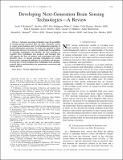Developing next-generation brain sensing technologies : a review
Abstract
Advances in sensing technology raise the possibility of creating neural interfaces that can more effectively restore or repair neural function and reveal fundamental properties of neural information processing. To realize the potential of these bioelectronic devices, it is necessary to understand the capabilities of emerging technologies and identify the best strategies to translate these technologies into products and therapies that will improve the lives of patients with neurological and other disorders. Here we discuss emerging technologies for sensing brain activity, anticipated challenges for translation, and perspectives for how to best transition these technologies from academic research labs to useful products for neuroscience researchers and human patients.
Citation
Robinson , J T , Pohlmeyer , E , Gather , M C , Kemere , C , Kitching , J E , Malliaras , G G , Marbleston , A , Shepard , K L , Stieglitz , T & Xie , C 2019 , ' Developing next-generation brain sensing technologies : a review ' , IEEE Sensors Journal , vol. 19 , no. 22 , 8772197 , pp. 10163 - 10175 . https://doi.org/10.1109/JSEN.2019.2931159
Publication
IEEE Sensors Journal
Status
Peer reviewed
ISSN
1530-437XType
Journal item
Collections
Items in the St Andrews Research Repository are protected by copyright, with all rights reserved, unless otherwise indicated.

